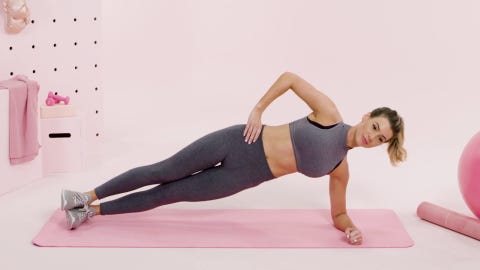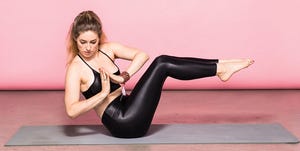Vanilla ice cream, a plain cheeseburger, that little black dress—sometimes keeping it simple is the most satisfying thing you can do. That goes for the core move you’ve probably done in almost every workout class of your life: the side plank.
Sure, holding a straight line isn’t as exciting as bicycle crunches, but it’ll make you more functional both in the gym and IRL. “Side planks are all about strengthening the side body and stabilizing your spine,” says Cara Bonney, CSCS, a Club Pilates master trainer in Dallas. That translates to being able to lift more—whether it’s a barbell or a kid.
And if you think the side plank is boring, well, you clearly haven’t tried the endless number of side plank variations.
How To Do A Side Plank

Women’s Health
How to: Lay on your side with your forearm flat on the floor, bottom elbow lined up directly under your shoulder and both legs extended out in a long line. Feet can either be staggered for more stability, or stacked for more of a challenge. Engage your core and lift your hips off the floor, forming a straight line from your head to your feet. Hold for 15 to 30 seconds. Your top hand can be on side of hip (easier) or reaching up to the ceiling (harder).
“The side plank works your postural muscles to help you stay upright and prevent injury.”
To make it easier, start with both knees bent, feet 90 degrees behind you, so you form a straight line from head to knees; lift and hold. To make it harder, keep your bottom leg bent but extend your top leg out, actively engaging your inner thigh as you push your top leg into the floor. (Watch Instagram-famous trainer Anna Victoria demo the move above.)
And for some harder side plank variations…
Side Plank With Hip Dip
How to: From side plank, lower your hips toward the ground a couple inches, then come back up to start. That’s one rep.
Side Plank With Knee Tuck
How to: Position yourself in a side plank, resting on your left forearm, with your right arm behind your head. Bring your right elbow in toward your belly, and bring your left knee to meet it. Then return to the starting position. That’s one rep.
Side Plank And Reach Through
How to: From your side plank position, slowly twist your chest until it’s parallel to the ground. As you do this, thread your right arm through the space between your body and the floor. Raise back to start. That’s one rep.
Form tips: “You should feel the abdominal draw in and cinch the waist feeling like a belt is lifting your waist/hips towards the ceiling,” says Bonney. In classic side plank, you should also keep your head in line with your spine and avoid looking down, which could compromise your cervical spine. Most importantly, in all variations, avoid sinking into the shoulder—you should feel like you’re pushing away from the floor at all times, says Bonney.
Reps/sets for best results: Stick to that 30 second max, or 10 to 15 reps, on all variations. If you want more of a burn, lower, pause, and repeat. “I would rather clients do a few shorter planks with great form than hold for minutes and start sinking into the hips and shoulders,” says Bonney.
Benefits Of A Side Plank
Yeah, they look cool—but what are muscles are used in side plank? According to Bonney, this move works your entire core. “The core isn’t just your abdominals; it’s all your trunk muscles, including your hips and back erector spinal muscles,” she says.



It primarily uses the oblique abdominal muscles, but your gluteus medius and gluteus maximus—the side and back hip muscles—are put to work to help stabilize the hips. Plus, your shoulder stabilizers keep you in alignment, says Bonney.
One huge perk of this move is it’s super safe even for people who have back or disc injuries. While a lot of core moves involve curling your spine and putting pressure on your low back or neck (think: situp, bicycle crunch), the side plank doesn’t flex or compress your spine.
Make Side Planks Part Of Your Workout
Because it’s such a great and safe stabilizer, you should try and lift into side plank as many days of the week as you can—at least every time you exercise, says Bonney.
Incorporate them at the beginning or end of a cardio day, or as a rest interval during interval training, to make the most of every minute but still allow your heart rate to return to normal.
Her favorite way to work them into a routine? The around the world plank. Start with a low plank (face down), then turn into a side plank. Then, flip up into a reverse plank (hands behind you on the ground, chest facing up), and move into a side plank on the other side. Hold each for 15 to 30 seconds, then go around the world again if your core is up for it.
Source: Read Full Article
